Waterfowl and Working Lands
Conservation partnerships with farmers and ranchers provide important wildlife and help keep agriculture operations profitable
Conservation partnerships with farmers and ranchers provide important wildlife and help keep agriculture operations profitable
By Kellis Moss, Becky Jones Mahlum, Brad Schmidt, and Kyle Soileau
From the Central Valley of California to the Chesapeake Bay, partnerships make it possible for Ducks Unlimited to conserve wetlands and fill the skies with waterfowl today, tomorrow, and forever. Many of these partnerships are formed with private landowners, farmers, and ranchers who produce the food, fiber, and fuel we all need. Their lands also provide crucial habitat for waterfowl and other wildlife.
In the 1930s, Congress established an agency to help people help the land. Today this agency is called the Natural Resources Conservation Service (NRCS), a branch of the US Department of Agriculture. Farmers, ranchers, conservation organizations, and others work with the NRCS to deliver voluntary, incentive-based programs. Agricultural producers participate in these programs to improve working lands across the country, including those places where waterfowl breed, nest, rest, and winter. Here are three examples of how these stewards of the land are implementing conservation practices that benefit their operations as well as the continent's waterfowl.
Joe Fritzsche farms near Wessington, South Dakota, with his wife, Lisa, and their four kids. Joe has been a part of the farming operation his whole life but has been at it full-time for 23 years. "I still have a lot to learn, and I want to keep learning to be successful," he says.
The Fritzsche family started using no-till farming methods in the early 1990s, when Joe's father bought their first no-till planter. "Dad bought the planter to be more efficient, because tillage just took way too much time," Joe remembers. "Soil health wasn't even on my mind at that time." The biggest thing he has learned since then is patience. "When I first started farming, I wanted to farm every acre. I wish I knew then what I know nowto go back and farm in nature's imageand we would be a lot further along."
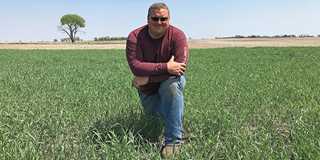
Joe Fritzsche is maximizing profits and wildlife benefits on his South Dakota farm.
Photo Becky Jones Mahlum/Ducks Unlimited
The Fritzsche family's farming practices and mind-set have shifted from wanting to farm as many acres as possible to maximizing profits and wildlife benefits on the acres they currently farm. Their first experience with cover crops was in 2004, but Joe freely admits that he had no idea what he was doing at the time. Now, he incorporates no-till farming methods on all his acres, he plants cover crops wherever and whenever he can, he diversifies his crop rotation to include small grains, and he is integrating livestock into his operation. "I'd like to have livestock on all my acres to have the same type of impact the bison once had on this land," he says.
The Fritzsches have been working with DU for a couple of years. "DU is really on the right track, working with farmers and ranchers to break that barrier and work together," Joe says. "The healthier our soils are, the more ducks and other wildlife we will have." He also says he really enjoys working with DU Agronomist Brad Schmidt, because it is nice to have someone with technical expertise as they try new practices in what can be a challenging environment.
Joe is excited for the future and where his farm and family are headed. His main goals are to keep the soil covered, plant cover crops, rotate different crops, and integrate livestock back onto cropland. He wants to plant more small grains like winter wheat and winter rye, which provide good nesting cover for ducks in spring. That will allow him to plant more cover crops and create more grazing potential for livestock. "Hopefully, in the future I can have one third of my acres in a full-season cover crop for grazing," he says.
DU has been able to help the Fritzsches secure conservation easements on 320 acres of their land while keeping those acres in productive agriculture. DU has also worked with the family to secure an Environmental Quality Incentives Program (EQIP) contract through the NRCS Regional Conservation Partnership Program (RCPP), which addresses on-farm, watershed, and regional natural resource concerns through partnerships with Ducks Unlimited and others. In cases like this, DU provides additional financial assistance to producers to improve soil health and enhance grassland and wetland habitats. The Fritzsches' contract provided funding for over 35,000 feet of permanent fencing to incorporate livestock on their cropland. The project also included temporary fencing materials, year-round energy-free livestock watering systems, full-season grazing cover crops, and native grass seedings. "It is very humbling and joyful to work with such great people like Joe and Lisa. It makes my job super fun and rewarding to work with folks who have such a love for the land and their family," says DU's Brad Schmidt.
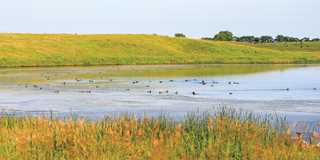
Photo Dean Pearson
Paul Johnson is a rice grower and avid duck hunter who manages 6,000 acres near Thornwell, Louisiana. In 2020 he will plant many of his acres in Jazzman rice, an aromatic variety developed by the Louisiana State University AgCenter. He manages the remaining acres for waterfowl hunting for Henning's Guide Service at Thornwell Oaks Hunting Lodge. Johnson guided duck and goose hunters for 15 years, but he recently retired from guiding to concentrate on the rice farm while working to improve wildlife habitat throughout his operation.
In 2013, Ducks Unlimited and the USA Rice Federation came together to form the Rice Stewardship Partnership with the shared goals of conserving waterfowl habitat, expanding working rice lands, and improving water quality and quantity. Johnson originally heard about the Rice Stewardship Partnership through his association with USA Rice. Johnson also heard Kyle Soileau, DU's rice stewardship coordinator in Louisiana, give RCPP reports at Louisiana Rice Growers Association meetings and talk about conservation programs available through the US Farm Bill.
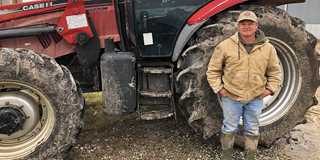
Through the Rice Stewardship Partnership, Paul Johnson is able to improve his operation for rice production and wildlife.
Photo Kyle Soileau/Ducks Unlimited
Johnson had been interested in improving waterfowl habitat on his farm but felt that his options were cost prohibitive. When he began participating in the Rice Stewardship Partnership, Johnson applied to an RCPP program and was approved. That meant he could move forward with plans to improve his operation for both wildlife habitat and rice production. "Because of the habitat we are developing, we have held more waterfowl, both ducks and geese, than a lot of our neighbors," Johnson says. "We also had a very consistent specklebelly season this year. We have created 6,000 acres of perfect habitat that supports not only more waterfowl but also many more species of waterbirds."
Johnson participates in the Conservation Stewardship Program (CSP) through the Gulf Coast Water and Wildlife RCPP. These programs are helping Johnson with three distinct practices in his operation: providing late-winter waterfowl habitat by holding rainwater on about 3,000 acres, reducing the risk of excess nutrient flow into surface water, and evaluating irrigation pumps on the farm to improve irrigation efficiency and reduce pumping costs.
Johnson believes that the Rice Stewardship Partnership has had a substantial impact on rice growers. With five RCPP projects in Louisiana, the partnership has brought an additional $15 million to rice growers through EQIP and CSP. Johnson credits this success to tremendous outreach activities by DU and USA Rice staff. "I see them at every rice clinic, field day, or grower meeting I attend. They work closely with all the local NRCS and Soil and Water Conservation District offices to get the word out on new programs. They are always willing to answer any questions I have, assist with record keeping if necessary, and come out to the farm when I need them," he says. "Any rice growers who don't take the time to learn about these programs are doing themselves a disservice." The practices implemented on the farm have been very beneficial so far, and Johnson plans on expanding the list of practices in the future.

Photo Ed Wall/Drake Waterfowl
Johnson credits conservation practices with bringing the birds back year after year. "Although a lot of hunting operations in southwest Louisiana reported a poor duck season, which was due to many factors, ours remained steady and better than most in the area. I firmly believe the future of waterfowl hunting in southwest Louisiana comes down to creating the perfect habitat," Johnson says.
North Dakota ranchers Cole and Brianna Johnson make decisions about their operation based on how those decisions will affect their bottom line. Cole says they decided to adopt soil-health practices because it was a simpler, more cost-effective way to improve their land and increase profits. "Ecology and economics go hand in hand out here," Cole says. "If we take care of the land and resources provided to us, it will improve our bottom line."
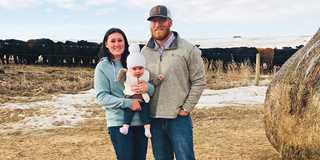
DUs soil health program is helping the Johnson family leave a conservation legacy for the next generation.
Photo Ducks Unlimited
The Johnsons participated in Ducks Unlimited's soil health program, which encourages regenerative agriculture practices to improve soil health and wildlife habitat. However, Cole has been experimenting with new techniques for a long time. "I bought my first set of cows when I was 13 and was fortunate enough to rent a small pasture from my dad," he says. "I couldn't afford a four-wheeler, so I split the pasture in half just so I could manage the cattle on foot. After moving the cattle a few times, I noticed the grass had improved immensely. That was long before I knew about rotational grazing."
When the Johnsons had the opportunity to buy land, they did not have the money to purchase a full line of equipment, so they partnered with an area producer and tried growing cash crops and feed for cattle. However, it was not practical to harvest the crop, haul it back for the cattle to eat, and then haul the manure back to the field. "That's when we started our trial-and-error period with cover crops," Cole says. "Having year-round cover on our marginal soils made sense, and, with the cows grazing the cover crops, we drastically cut some equipment expense."
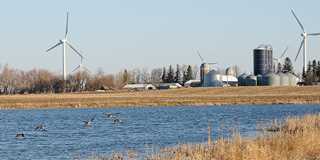
Continued support for conservation programs will help provide additional opportunities for habitat work in the future.
Photo Jim Thompson
Ducks Unlimited partnered with the Johnsons on some of their cover crops and helped share the cost of fencing and watering systems for the cattle. "Having a partner like DU reassured us that we were making the right moves on improving soil health," Cole says.
The couple now has 600 cows, in cooperation with an area farmer, and are looking to expand. With better rest and recovery periods for the grass and by grazing crop fields, Cole says they can handle more cow-calf pairs on fewer acres. "Just the production costs on that makes more sense than trying to raise cash crops on the land," Cole explains.
The Johnsons communicate frequently with other landowners, letting them know what they are doing or intending to do to improve the land they are working, which helps build long-lasting relationships. "We are taking the proper steps forward to ensure the land will be in better shape for the next generation. For us, soil health is above profit, in the sense that if we manage it correctly, it will give us an even greater return," Cole says. "It's a give-and-take relationship, and I think cover crops, livestock integration, and proper rotational grazing are some key steps."

Rotational grazing systems lead to healthier grass and better habitat for northern pintails and other ducks.
Photo TODDSTEELEPHOTOART.COM
Cole explains that making it in agriculture today means producers must start doing things differently. "Markets and weather are out of our control, but inputs and management can be somewhat regulated. In today's agricultural economy it's easy to become depressed. I believe if we change some practices and are willing to adapt some new techniques, it can be exciting again," he says. "I'm really looking forward to the future to see how we can improve our ranch's soil health and profitability."
From the prairies to the Gulf Coast, partnerships among landowners, producers, the NRCS, Ducks Unlimited, and others are driving conservation and helping producers stay profitable, while also creating more wildlife habitat and improving soil health. Continued support for programs like RCPP in Congress will allow these voluntary, incentive-based programs to continue. Through healthy partnerships, Ducks Unlimited and the farming and ranching community will thrive.
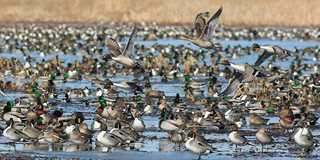
Flooded rice fields provide important habitat for waterfowl in key wintering areas.
Photo DOUGSTEINEKE.COM
Kellis Moss is director of public policy in DU's Washington, DC, office. Becky Jones Mahlum is manager of conservation programscommunications and outreach in DU's Great Plains Region. Brad Schmidt is a DU agronomist in South Dakota. Kyle Soileau is DU's rice stewardship coordinator in Louisiana.
Ducks Unlimited uses cookies to enhance your browsing experience, optimize site functionality, analyze traffic, and deliver personalized advertising through third parties. By continuing to use this site, you agree to our use of cookies. View Privacy Policy